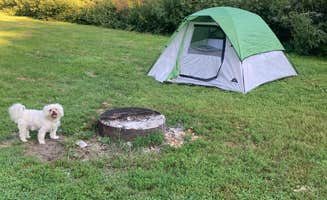Richard J Dorer Memorial Hardwood Forest offers dispersed camping across several units in southeastern Minnesota. Near Spring Valley, campers can access primitive sites in undeveloped areas with varying terrain and seasonal access conditions. The forest's dispersed camping sites provide cost-effective alternatives to developed campgrounds in the region.
What to do
Hiking trails access: The forest has trail systems that connect to some camping areas. "There are a few spaces with views you can hike in to but I opted for a spot next to my car. And ideal spot for a one nighter. I stopped here after a 12 hour drive got set up and even walked the trails for a few miles before bed," notes one visitor to Richard J Dorer Memorial Hardwood Forest.
Water activities: Root River provides opportunities for paddlers looking for water-based camping. The campsite location requires boat access or walking. The site's relationship to the water has changed over time, with the river now positioned farther from the camping area than in previous decades.
Explore forest roads: Zumbro Bottoms State Forest offers drive-in dispersed camping accessed via dirt roads. "This area is off a low maintenance dirt road. It is best to come in from the south as sometimes the gate on the river bridge to the north is closed. There is a parking spot near a known dispersed camping site with easy vehicle access next to it," explains a camper at Zumbro Bottoms State Forest.
What campers like
Secluded locations: Many dispersed sites provide more privacy than established campgrounds. Campers can find spots away from crowds, particularly on weekdays or during shoulder seasons.
Cost savings: Free camping near Spring Valley, Minnesota appeals to budget-conscious travelers. The no-fee policy at Richard J Dorer forest units makes it popular for overnight stays.
Accessibility options: Some areas offer both challenging and easier camping options. "There are a few spaces with views you can hike in to but I opted for a spot next to my car," explains one Root River Canoe Campsite visitor who appreciated having choices based on their energy level.
What you should know
Variable road conditions: Access to dispersed camping areas can be complicated by seasonal road conditions. "This area is off a low maintenance dirt road. It is best to come in from the south as sometimes the gate on the river bridge to the north is closed," advises a Zumbro Bottoms camper.
Pack-in/pack-out required: No trash services exist at these primitive sites. All waste must be carried out by campers.
Multi-use areas: The forests allow various recreational activities that may overlap with camping areas. Hiking trails pass through some camping zones, and hunters use the forests during appropriate seasons.
Tips for camping with families
Consider physical abilities: When selecting sites, factor in hiking difficulty, especially with children. "The hike up the hill to the overlook is a daunting one. We used a collapsible wagon to haul all the supplies up the hill," reports one Richard J Dorer Memorial Hardwood Forest visitor, suggesting equipment to help with challenging terrain.
Plan for limited facilities: Prepare children for primitive camping with minimal amenities. Most sites have only basic facilities like fire rings and possibly pit toilets.
Bring plenty of water: No potable water sources exist at many dispersed sites, requiring families to pack in all necessary drinking water for their stay.
Tips from RVers
Site limitations: Large RVs face significant challenges at most dispersed sites near Spring Valley. The forest roads and primitive camping areas cannot accommodate big rigs or provide any hookups.
Alternative parking: Some RV owners use smaller vehicles to access camping sites after parking their RV at designated trailheads or forest access points.
Seasonal considerations: Spring and fall often provide better conditions for smaller RVs or truck campers to navigate forest roads compared to potentially muddy summer periods after heavy rainfall.


